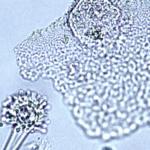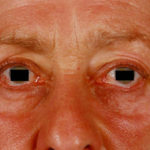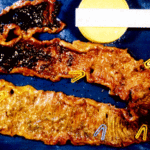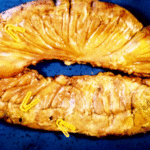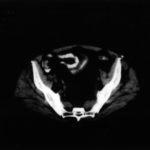Date: 26 November 2013
Copyright: n/a
Notes:
Dr Jenny Bartholomew is a Research Associate in the Institute of Inflammation and Repair, University of Manchester. A Manchester graduate – she formerly worked as a University Lecturer at Monash University, Melbourne for four years where she undertook research into the immunology of connective tissue damage and repair in rheumatoid arthritis, identifying TNF alpha in inflamed cartilage in an animal model of arthritis.
On returning to Manchester she moved to Christie Hospital, Manchester as a Research Fellow and University teacher where her main research interests were studying the immunological responses to human papillomavirus (HPV 16/18) in cervical cancer. Using recombinant vaccinia virus to express viral proteins from HPV, the major oncoproteins from HPV were studied and used in the development of the cervical cancer vaccine.
For the last 12 years she has been involved in Aspergillus research, providing clinical and scientific information to patients, doctors and scientists, she manages and publishes the Aspergillus website. This is a complex educational resource providing the latest research, technology and information for a wide diversity of users. She has a particular interest in video media and produces a broad range of video interviews from patients and clinics for educational use.
She is now engaged in global health programme. Jenny has launched the LIFE (Leading International Fungal Education) programme commencing with a public engagement and awareness project in 2012, combining Science with Art, aimed at educating young people about harmful fungi.
This was followed by the LIFE online resource (http://life-worldwide.org) for health care professionals encompassing all fungi, the infections they cause, diagnosis and treatments. This resource has a news flow about global health and is targeting global education about fungi and serious infections they can cause. The site is now being translated into Spanish and other languages will follow soon. She launched the Global Action Fund for Fungal Infection site (http://gaffi.org) in July 2013 – GAFFI is a foundation based in Geneva, focused on advocacy for access to diagnostics and treatment in every country.
Aspergillus website, Life worldwide organisation, GAFFI , National Aspergillosis Centre, Mycology Reference Laboratory and Fungal Infection Trust.
Some of my Publications:
- Bartholomew, J S, J M Evanson and DE Woolley . Rheumatol. Int., II: 37-40, 1991 Serum IgE Anti-cartilage Collagen Antibodies in Rheumatoid Patients.
- Bartholomew,J S,J M Evanson and DE Woolley . Allergy Digests, 2: 30-31, 1992 Collagen Specific IgE Antibodies in Rheumatoid Patients.
- Stacey,S N, J S Bartholomew, A Ghosh, P L Stern, M Mackett and J R Arrand. J.Gen. Vir., 73: 2337-2345, 1992 Expression of human papillomavirus type 16 E6 protein by recombinant baculovirus and use for detection of anti-E6 antibodies in human sera.
- Stacey,S N, A Ghosh, J S Bartholomew, R W Tindle, P L Stern, M Mackett and J R Arrand. J. Med. Virol., 40: 14-21, 1993. Expression of human papillomavirus type 16 E7 protein by recombinant baculovirus and use for the detection of E7 antibodies in sera from cervical carcinogen patients.
- Bartholomew,JS, S N Stacey, B Coles, D Burt, I R Arrand and P L Stern. European Journal of Immunology, 24: 3175-3179, 1994 Identification of a naturally processed HLA-A0201 restricted viral peptide from cells expressing human papillomavirus type 16 E6 oncoprotein.
- Bartholomew J and P L Stern.
In: Modulation of MHC Antigen Expression and Disease. Eds E G Blair, D J Maudsley and C P Pringle, 233-250, 1994 MHC expression in HPV associated cervical cancer. - Ellis JRM, P I Keating, J Baird, E F Hounsell, D V Renouf, M Rowe, D Hopkins, M F Duggan-Keen, J.S Bartholomew, L S Young and P L Stern. Nature Medicine, 1,464-470, 1995 An HP V 16 variant is associated with cervical carcinoma in HLA-B7 positive women.
- Bartholomew,JS, S. Glenville, S. Sarkar, D.I. Burt, M.A. Stanley, F. Ruiz-Cabens, J. Chengang, F. Garrido and P .L. Stern. Cancer Res. March 1, 1997. Integration of high-risk human papillomavirus DNA is linked to the down-regulation of Class I Human leukocyte antigens by steroid hormones in cervical tumour cells.
- Brady CS. Bartholomew JS. Burt DJ. Duggan-Keen MF. Glenville S. Telford N. Little AM. Davidson JA. Jimenez P. Ruiz-Cabello F. Garrido F. Stern PL.
Tissue Antigens. 55(5):401-11, 2000 May. Multiple mechanisms underlie HLA dysregulation in cervical cancer. - Fungi: friends or foes? Biological Sciences Review 17(1) 24-28, 2004
-
Mabey Gilsenan JE, Atherton G, Bartholomew J, Giles PF, Attwood TK, Denning DW, Bowyer P.
Aspergillus genomes and the aspergillus cloud Nucleic Acids Res. 2009 Jan;37(Database issue):D509-14. Epub 2008 Nov 27
E-mail: jennifer.bartholomew@manchester.ac.uk
Images library
-
Title
Legend
-
Aspergillus flavus and Aspergillus parasiticus can produce aflatoxins are generally known as storage fungi, but they can also cause ear rots in the field. These species are observed as a gray-green, powdery molds and they can be detected in corn because they produce compounds that are fluorescent under black light.
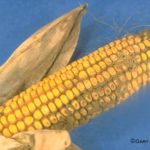
-
Histopathology of the jejenum showing necrosis and hyphae consistent with Aspergillus
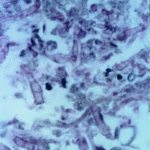
-
Further image details
Image A. Multiple small lesions at both ends of the cordae tendinae in this patient who died of disseminated aspergillosis. He was a previously well 70 year old man who developed pneumonia on holiday, required artificial ventilation and died with a rapidly progressive cavitating pneumonia. Autopsy showed disseminated aspergillosis.
Image B. Another lesion in pt DB, that histologically showed a mass of hyphae and fibrin.
Image C. Large destructive lesion on the mitral valve in patient DB.
 ,
,  ,
, 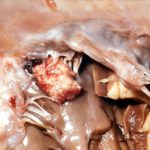
-
The patient was a 610 g twin male born by spontaneous normal vaginal delivery at 23 weeks and 4 days gestation. He was started on benzyl penicillin and gentamicin for sepsis. On day 3, he developed metabolic acidosis, hyponatremia, anemia, thrombocytopenia and jaundice and his antibiotics were changed to vancomycin, cefotaxime and fluconazole.
On day 10, multiple circular skin papules with white eschars were noted on his back (Figure A). A full septic screen was repeated including skin scraping and biopsy for urgent microscopy and culture. Microscopy of skin scrapes revealed fungal elements including hyphae and fruiting heads suggestive of Aspergillus spp (Figure B). Lipid amphotericin B was commenced and fluconazole was stopped. Skin scrapings on culture grew Aspergillus fumigatus. A diagnosis of primary cutaneous aspergillosis was made. The patient responded to oral posaconazole 6mg/kg/8 hourly. All lesions disappeared after 44 days and he continued with posaconazole until day 60.
Published case at Langan et al Pediatr Dermatol 2010 Jul-Aug 27 (4) 403-4
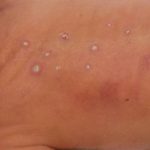 ,
, 